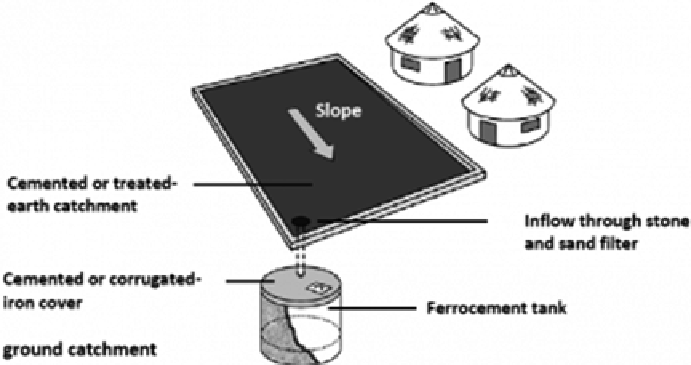Agriculture Reference
In-Depth Information
Fig. 12.7
Ground catchment system
Fusarium wilt was reduced when a lower drip
irrigation rate was used. In general, the use of
low-cost drip irrigation is cost-effective, labor-
saving, and allows more plants to be grown per
unit of water, thereby both saving water and
increasing farmers' incomes at the same time.
Prominent (adaptation) technologies in this
area are:
local surface runoff (rain or surface water fl ow
that occurs when soil is infi ltrated to full capac-
ity) for agriculture in arid and semiarid regions
(Boers and Ben-Asher
1982
). Both small- and
large-scale structures are used for rainwater
harvesting collection and storage including water
pans, tanks, reservoirs, and dams. The catchment
area is the area where the rainfall or water runoff
is initially captured and is in most cases either the
ground surface or rock surface.
Rainwater harvesting
Sprinkler irrigation
Drip irrigation
12.3.2.1 Ground-Surface
In the ground surface method, water fl owing
along the ground during the rains is usually
diverted towards a tank below the surface
(Fig.
12.7
). There is greater possibility of water
loss due to infi ltration into the ground. The water
is generally of lower quality than that collected
directly from rainfall. Techniques available for
increasing runoff within ground catchment areas
include (1) clearing or altering vegetation cover,
(2) increasing the land slope with artifi cial ground
cover, and (3) reducing soil permeability by soil
compaction and application of chemicals (UNEP
1982
). Impermeable membranes can also be used
to facilitate runoff. Ground catchment is applica-
ble for low topographic areas and is suitable for
large-scale agricultural production as it allows
for in situ storage and usage of fresh water for
irrigation.
Fog harvesting
12.3.2 Rainwater Harvesting
Rainfall can provide some of the cleanest natu-
rally occurring water that is available. There is
considerable scope for the collection of rainwater
when it falls, before huge losses occur due to
evaporation, transpiration, and runoff and drain-
age - before it becomes contaminated by natural
means or man-made activities. Rainwater har-
vesting is a particularly suitable technology for
areas where there is no surface water, or where
groundwater is deep or inaccessible due to hard
ground conditions, or where it is too salty or
acidic.
Rainwater harvesting is defi ned as a method
for inducing, collecting, storing, and conserving

Search WWH ::

Custom Search